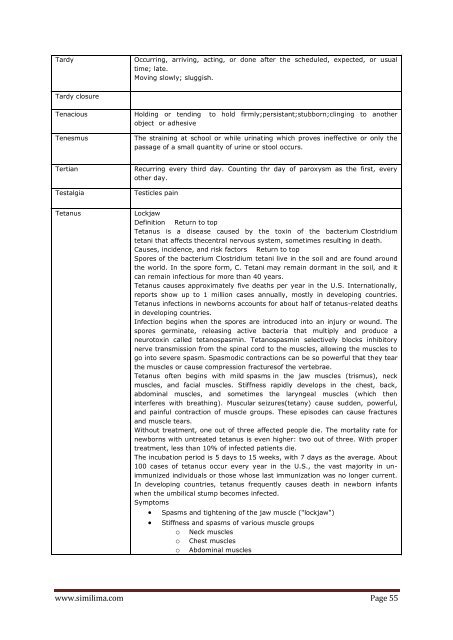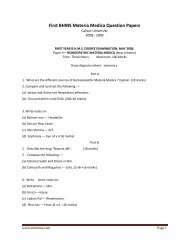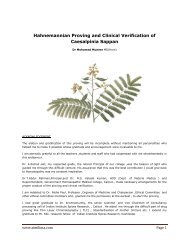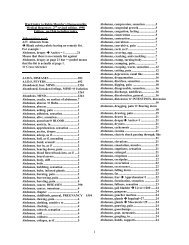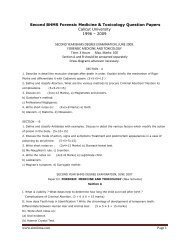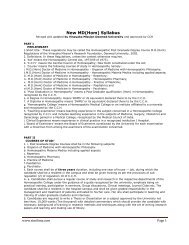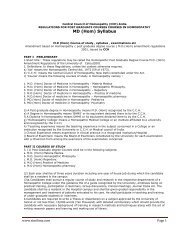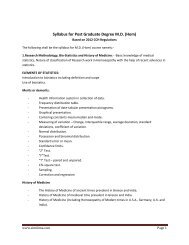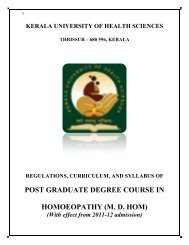Denotations & Old terminologies used in Homopathy - Similima
Denotations & Old terminologies used in Homopathy - Similima
Denotations & Old terminologies used in Homopathy - Similima
Create successful ePaper yourself
Turn your PDF publications into a flip-book with our unique Google optimized e-Paper software.
Tardy Occurr<strong>in</strong>g, arriv<strong>in</strong>g, act<strong>in</strong>g, or done after the scheduled, expected, or usual<br />
time; late.<br />
Mov<strong>in</strong>g slowly; sluggish.<br />
Tardy closure<br />
Tenacious Hold<strong>in</strong>g or tend<strong>in</strong>g to hold firmly;persistant;stubborn;cl<strong>in</strong>g<strong>in</strong>g to another<br />
object or adhesive<br />
Tenesmus The stra<strong>in</strong><strong>in</strong>g at school or while ur<strong>in</strong>at<strong>in</strong>g which proves <strong>in</strong>effective or only the<br />
passage of a small quantity of ur<strong>in</strong>e or stool occurs.<br />
Tertian Recurr<strong>in</strong>g every third day. Count<strong>in</strong>g thr day of paroxysm as the first, every<br />
other day.<br />
Testalgia Testicles pa<strong>in</strong><br />
Tetanus Lockjaw<br />
Def<strong>in</strong>ition Return to top<br />
Tetanus is a disease ca<strong>used</strong> by the tox<strong>in</strong> of the bacterium Clostridium<br />
tetani that affects thecentral nervous system, sometimes result<strong>in</strong>g <strong>in</strong> death.<br />
Causes, <strong>in</strong>cidence, and risk factors Return to top<br />
Spores of the bacterium Clostridium tetani live <strong>in</strong> the soil and are found around<br />
the world. In the spore form, C. Tetani may rema<strong>in</strong> dormant <strong>in</strong> the soil, and it<br />
can rema<strong>in</strong> <strong>in</strong>fectious for more than 40 years.<br />
Tetanus causes approximately five deaths per year <strong>in</strong> the U.S. Internationally,<br />
reports show up to 1 million cases annually, mostly <strong>in</strong> develop<strong>in</strong>g countries.<br />
Tetanus <strong>in</strong>fections <strong>in</strong> newborns accounts for about half of tetanus-related deaths<br />
<strong>in</strong> develop<strong>in</strong>g countries.<br />
Infection beg<strong>in</strong>s when the spores are <strong>in</strong>troduced <strong>in</strong>to an <strong>in</strong>jury or wound. The<br />
spores germ<strong>in</strong>ate, releas<strong>in</strong>g active bacteria that multiply and produce a<br />
neurotox<strong>in</strong> called tetanospasm<strong>in</strong>. Tetanospasm<strong>in</strong> selectively blocks <strong>in</strong>hibitory<br />
nerve transmission from the sp<strong>in</strong>al cord to the muscles, allow<strong>in</strong>g the muscles to<br />
go <strong>in</strong>to severe spasm. Spasmodic contractions can be so powerful that they tear<br />
the muscles or cause compression fracturesof the vertebrae.<br />
Tetanus often beg<strong>in</strong>s with mild spasms <strong>in</strong> the jaw muscles (trismus), neck<br />
muscles, and facial muscles. Stiffness rapidly develops <strong>in</strong> the chest, back,<br />
abdom<strong>in</strong>al muscles, and sometimes the laryngeal muscles (which then<br />
<strong>in</strong>terferes with breath<strong>in</strong>g). Muscular seizures(tetany) cause sudden, powerful,<br />
and pa<strong>in</strong>ful contraction of muscle groups. These episodes can cause fractures<br />
and muscle tears.<br />
Without treatment, one out of three affected people die. The mortality rate for<br />
newborns with untreated tetanus is even higher: two out of three. With proper<br />
treatment, less than 10% of <strong>in</strong>fected patients die.<br />
The <strong>in</strong>cubation period is 5 days to 15 weeks, with 7 days as the average. About<br />
100 cases of tetanus occur every year <strong>in</strong> the U.S., the vast majority <strong>in</strong> unimmunized<br />
<strong>in</strong>dividuals or those whose last immunization was no longer current.<br />
In develop<strong>in</strong>g countries, tetanus frequently causes death <strong>in</strong> newborn <strong>in</strong>fants<br />
when the umbilical stump becomes <strong>in</strong>fected.<br />
Symptoms<br />
Spasms and tighten<strong>in</strong>g of the jaw muscle ("lockjaw")<br />
Stiffness and spasms of various muscle groups<br />
o Neck muscles<br />
o Chest muscles<br />
o Abdom<strong>in</strong>al muscles<br />
www.similima.com Page 55


